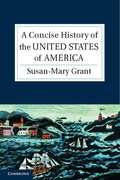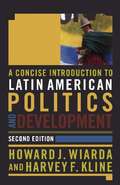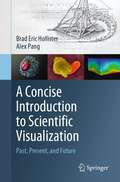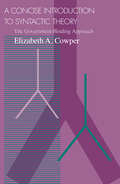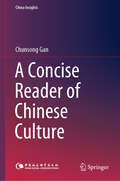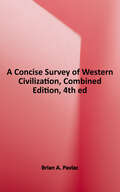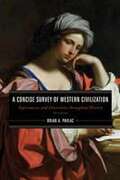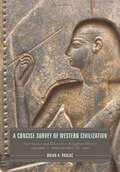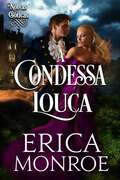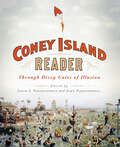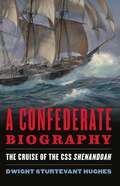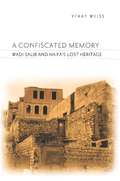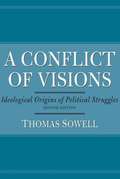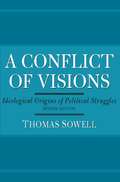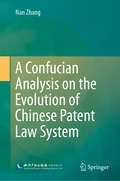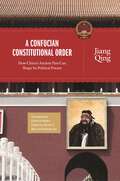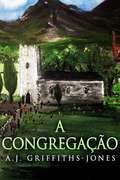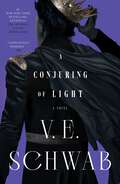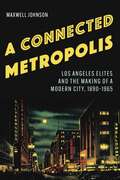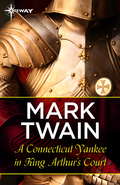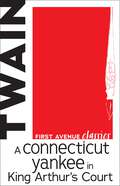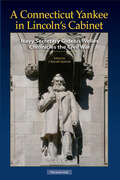- Table View
- List View
A Concise History of the United States of America
by Susan-Mary GrantBorn out of violence and the aspirations of its early settlers, the United States of America has become one of the world's most powerful nations. The book begins in colonial America as the first Europeans arrived, lured by the promise of financial profit, driven by religious piety and accompanied by diseases which would ravage the native populations. It explores the tensions inherent in a country built on slave labour in the name of liberty, one forced to assert its unity and reassess its ideals in the face of secession and civil war, and one that struggled to establish moral supremacy, military security and economic stability during the financial crises and global conflicts of the twentieth century. Woven through this richly crafted study of America's shifting social and political landscapes are the multiple voices of the nation's history: slaves and slave owners, revolutionaries and reformers, soldiers and statesmen, immigrants and refugees. These voices help define the United States at the dawn of a new century.
A Concise Introduction to Latin American Politics and Development
by Howard J. Wiarda Harvey F. KlineThis succinct overview of the political factors that condition social and economic development in Latin America is the perfect core text in courses on politics, government, social change, and transitions to democracy throughout Latin America and the Caribbean.
A Concise Introduction to Scientific Visualization: Past, Present, and Future
by Brad Eric Hollister Alex PangScientific visualization has always been an integral part of discovery, starting first with simplified drawings of the pre-Enlightenment and progressing to present day. Mathematical formalism often supersedes visual methods, but their use is at the core of the mental process. As historical examples, a spatial description of flow led to electromagnetic theory, and without visualization of crystals, structural chemistry would not exist. With the advent of computer graphics technology, visualization has become a driving force in modern computing. A Concise Introduction to Scientific Visualization – Past, Present, and Future serves as a primer to visualization without assuming prior knowledge. It discusses both the history of visualization in scientific endeavour, and how scientific visualization is currently shaping the progress of science as a multi-disciplinary domain.
A Concise Introduction to Syntactic Theory: The Government-Binding Approach
by Elizabeth A. CowperThis textbook is intended to give students a quick start in using theory to address syntactic questions. At each stage, Cowper is careful to introduce a theoretical apparatus that is no more complex than is required to deal with the phenomenon under consideration. Comprehensive and up-to-date, this accessible volume will also provide an excellent refresher for linguists returning to the study of Government-Binding theory. "Cowper exhibits the analytical devices of current principles-and-parameters approaches, takes readers carefully through the central elements of grammatical theory (including very recent work), and ushers them selectively into the technical literature. . . . A serious introduction for those who want to know the nuts and bolts of syntactic theory and to see why linguists are so excited these days."—David Lightfoot, University of Maryland "An excellent short introduction to the Government and Binding model of syntactic theory. . . . Cowper's work succeeds in teaching syntactic argumentation and in showing the conceptual reasons behind specific proposals in modern syntactic theory."—Jaklin Kornfilt, Syracuse University
A Concise Reader of Chinese Culture (China Insights)
by Chunsong GanThis book uses the mutual interactions between Chinese and Western culture as a point of departure in order to concisely introduce the origins and evolution of Chinese culture at the aspects of constitution, thinking, values and atheistic. This book also analyzes utensil culture, constitution culture and ideology culture, which were perfected by absorbing classic arguments from academia. As such, the book offers an essential guide to understanding the development, civilization and key ideologies in Chinese history, and will thus help to promote Chinese culture and increase cultural awareness.
A Concise Survey of Western Civilization, Combined Edition: Supremacies and Diversities Throughout History
by Brian A. PavlacThis book gives a brief, readable description of our common Western heritage. It covers the minimum historical information that educated adults should know within a tightly focused narrative and interpretive structure. The joined terms "supremacies and diversities" develop major themes of conflict and creativity. "Supremacies" centers on the use of power to dominate societies, ranging from warfare to ideologies. Supremacy seeks stability, order, and incorporation. "Diversities" encompasses the creative impulse that produces new ideas, as well as people's efforts to define themselves as "different." Diversity creates change, opportunity, and individuality. These themes of historical tension and change, whether applied to political, economic, technological, social and cultural trends, offer a bridging explanatory organization. Five other topical themes regularly inform the text: technological innovation, migration and conquest, political and economic decision-making, church and state, and disputes about the meaning of life. Various "Basic Principles" present summaries of historical realities. Primary Source Projects and Sources on Families offer students the chance to evaluate differing points of view about the past. This text is less expensive, less formal, has more attitude, yet still provides all the essentials for a course on Western Civilization.
A Concise Survey of Western Civilization: Supremacies and Diversities Throughout History
by Brian A. PavlacThis engaging text offers a concise, readable description of our common Western heritage. Providing a tightly focused narrative and interpretive structure, the author covers the basic historical information that all educated adults should know. His joined terms “supremacies and diversities” develop major themes of conflict and creativity throughout history. <p><p>“Supremacies” centers on the use of power to dominate societies, ranging from warfare to ideologies. Supremacy, he shows, seeks stability, order, and incorporation. <p><p>“Diversities” encompasses the creative impulse that produces new ideas, as well as efforts of groups of people to define themselves as “different.” Diversity creates change, opportunity, and individuality. <p><p>These concepts of historical tension and change, whether applied to political, economic, technological, social, or cultural trends, offer a cohesive explanatory organization. The text is also informed by five other topical themes: technological innovation, migration and conquest, political and economic decision-making, church and state, and disputes about the meaning of life.<p><p> The third edition has added new primary source projects, improved maps and illustrations to enhance the visual dimension, written with flair, this easily accessible yet deeply knowledgeable text provides all the essentials for a course on Western civilization.
A Concise Survey of Western Civilization: Supremacies and Diversities Throughout History - Prehistory to 1500
by Brian A. PavlacThis engaging text offers a brief, readable description of our common Western heritage as it began in the first human societies and developed in ancient Greece and Rome, then through the Middle Ages. Providing a tightly focused narrative and interpretive structure, Brian Pavlac covers the basic historical information that all educated adults should know. His joined terms 'supremacies and diversities' develop major themes of conflict and creativity throughout history. 'Supremacies' centers on the use of power to dominate societies, ranging from warfare to ideologies. Supremacy, Pavlac shows, seeks stability, order, and incorporation. 'Diversities' encompasses the creative impulse that produces new ideas, as well as efforts of groups of people to define themselves as 'different.' Diversity creates change, opportunity, and individuality. These concepts of historical tension and change, whether applied to political, economic, technological, social, or cultural trends, offer a cohesive explanatory organization. The text is also informed by five other topical themes: technological innovation, migration and conquest, political and economic decision-making, church and state, and disputes about the meaning of life. Throughout, judicious 'basic principles' present summaries of historical realities. Written with flair, this easily accessible yet deeply knowledgeable text provides all the essentials for a course on Western civilization. More information, study guides, and links to sources can be found on the book's website, www.concisewesternciv.com.
A Condessa louca (Noivas góticas #1)
by Erica MonroeO amor verdadeiro deve quebrar a maldição da loucura nesse romance regencial sombrio e cheio de emoções… Quando a mãe de Lady Claire Deering é internada num hospício, a sociedade não perde tempo para desprezar sua filha, apelidando-a como a “filha louca”. No entanto a reputação manchada é a menor de suas preocupações, pois os rumores carregam consigo uma verdade terrível e assustadora: as mulheres da família Deering são vítimas de uma maldição sombria lançada por bruxas. Se Claire se casar com seu amor verdadeiro, passará o resto da vida como escrava da loucura. Para se salvar, ela se mantém isolada... Até que a leitura de um testamento em um castelo misterioso, na véspera do dia de Todos os Santos, aproxima-a de seu mais querido amigo e sua paixão secreta. O tímido e estudioso Teddy Lockwood nunca encontrou uma regra que não ficasse feliz em seguir. Quando inesperadamente herda o condado de Ashbrooke, decide virar a página e se tornar um novo e corajoso homem — dirá a Claire que a ama desde que eram crianças. A leitura do testamento é a oportunidade perfeita para conquistar o coração dela, mesmo estando fora da zona de conforto no enigmático e sombrio castelo em Cornwall. Logo, a paixão reluzente entre eles se torna incontrolável. Agora, para salvar o amor de sua vida, Teddy fará o que for preciso para quebrar a maldição de Claire. Irá Claire passar o resto dos seus dias nas garras de uma loucura misteriosa ou o amor provará ser mais forte do que tudo? Esse conto foi anteriormente publicado na antologia Mystified.
A Coney Island Reader: Through Dizzy Gates of Illusion
by John Louis J. ParascandolaFeaturing a stunning gallery of portraits by the world's finest poets, essayists, and fiction writers--including Walt Whitman, Stephen Crane, José Martí, Maxim Gorky, Federico García Lorca, Isaac Bashevis Singer, E. E. Cummings, Djuna Barnes, Colson Whitehead, Robert Olen Butler, and Katie Roiphe--this anthology is the first to focus on the unique history and transporting experience of a beloved fixture of the New York City landscape.Moody, mystical, and enchanting, Coney Island has thrilled newcomers and soothed native New Yorkers for decades. With its fantasy entertainments, renowned beach foods, world-class boardwalk, and expansive beach, it provides a welcome respite from the city's dense neighborhoods, unrelenting traffic, and somber grid. Coney Island has long offered a kaleidoscopic panorama of people, places, and events, creating, as Lawrence Ferlinghetti once wrote, "a Coney Island of the mind." This anthology captures the highs and lows of that sensation, with works that imagine Coney Island as a restful resort, a playground for the masses, and a symbol of America's democratic spirit, as well as a Sodom by the sea, a garish display of capitalist excess, and a paradigm of urban decay. As complex as the city of which it is a part, Coney Island engenders limitless perspectives, a composite inspiring everyone who encounters it to sing its electric song.
A Confederate Biography: The Cruise Of Css Shenandoah
by Dwight HughesBased primarily on the words of those who lived it, A Confederate Biography is a comprehensive narrative of the cruise of the CSS Shenandoah. More than a thrilling sea story, the journey provides a window of historical perspective on the Civil War. From October 1864 to November 1865, the officers of the Shenandoah carried the Confederacy and the conflict around the globe and to the ends of the earth through every extreme of sea and storm. Their observations looking back from the most remote and alien surroundings imaginable, along with viewpoints of those they encountered, illuminate the hearts and minds of contestants North and South. These Americans stood together in defense of their country as they understood it, pursuing a difficult and dangerous mission in which they succeeded spectacularly after it no longer mattered. Through their eyes, the potentially decisive international arena of the war, governed by complex maritime and trade law, comes alive. The neutrality, or lack thereof, of major European powers was a central concern to both sides. Shenandoah was smack in the middle of this diplomatic maelstrom and contributed to it. And within the navy, a generational clash arose between antebellum orthodoxy and a professional officer corps emerging from the new Naval Academy, rapid technological advances, contemporary social reforms, and the crucible of war. This difference was manifest between the captain of Shenandoah and his young lieutenants. The men they led, however, were a polyglot assemblage of merchant sailors of nearly every nation and color--including several Yankees and African Americans--operating within its own rigidly authoritarian and cramped society. Shenandoah herself was a magnificent vessel, the epitome of rich and ancient maritime heritages, but also a paradigm of dramatic transitions from the small wooden sailing navy to the second largest, most powerful, and technologically advanced fleet in the world. Her commerce raiding mission was a watery form of asymmetric warfare in the spirit of John Mosby, Bedford Forrest, and W. T. Sherman. It was arguably the most successful military effort of the Confederacy in terms of cost versus mission accomplished, but the strategic effectiveness of the strategy remains questionable. Shenandoah fired the last gun of the Civil War, set the land of the midnight sun aglow with flaming Yankee whalers, and, seven months after Appomattox, lowered the last Confederate banner. This is a biography of a ship and a cruise, and a microcosm of the Confederate-American experience.
A Confiscated Memory: Wadi Salib and Haifa's Lost Heritage
by Yfaat WeissUntil the War of 1948, Wadi Salib was an impoverished Arab neighborhood in Haifa, Israel. A single day of fighting uprooted its residents. Yet Wadi Salib retained its Arab name, even after Jewish immigrants from Morocco resettled it, replacing one layer of existence with another. In 1959, Misrahi protest against continual discrimination turned the neighborhood and into an icon of ethnic strife between Israeli Jews. Nevertheless, its Arab inscription and the acts committed there lingered in its stones.
A Confiscated Memory: Wadi Salib and Haifa's Lost Heritage
by Yfaat WeissYfaat Weiss tells the story of an Arab neighborhood in Haifa that later acquired iconic status in Israeli memory. In the summer of 1959, Jewish immigrants from Morocco rioted against local and national Israeli authorities of European origin. The protests of Wadi Salib generated for the first time a kind of political awareness of an existing ethnic discrimination among Israeli Jews. However, before that, Wadi Salib existed as an impoverished Arab neighborhood. The war of 1948 displaced its residents, even though the presence of the absentees and the Arab name still linger.Weiss investigates the erasure of Wadi Salib's Arab heritage and its emergence as an Israeli site of memory. At the core of her quest lies the concept of property, as she merges the constraints of former Arab ownership with requirements and restrictions pertaining to urban development and the emergence of its entangled memory. Establishing an association between Wadi Salib's Arab refugees and subsequent Moroccan evacuees, Weiss allegorizes the Israeli amnesia about both eventual stories-that of the former Arab inhabitants and that of the riots of 1959, occurring at different times but in one place. Describing each in detail, Weiss uncovers a complex, multilayered, and hidden history. Through her sensitive reading of events, she offers uncommon perspective on the personal and political making of Israeli belonging.
A Conflict of Visions: Ideological Origins of Political Struggles
by Thomas SowellIn this classic work, Thomas Sowell analyzes the two competing visions that shape our debates about the nature of reason, justice, equality, and power. The "constrained" vision, which sees human nature as unchanging and selfish, and the "unconstrained" vision, in which human nature is malleable and perfectible. He describes how these two radically opposed views have manifested themselves in the political controversies of the past two centuries, including such contemporary issues as welfare reform, social justice, and crime. Updated to include sweeping political changes since its first publication in 1987, this revised edition of A Conflict of Visions offers a convincing case that ethical and policy disputes circle around the disparity between both outlooks.
A Conflict of Visions: Ideological Origins of Political Struggles
by Thomas SowellIn this classic work, Thomas Sowell analyzes the two competing visions that shape our debates about the nature of reason, justice, equality, and power: the "constrained" vision, which sees human nature as unchanging and selfish, and the "unconstrained" vision, in which human nature is malleable and perfectible. He describes how these two radically opposed views have manifested themselves in the political controversies of the past two centuries, including such contemporary issues as welfare reform, social justice, and crime. Updated to include sweeping political changes since its first publication in 1987, this revised edition of A Conflict of Visions offers a convincing case that ethical and policy disputes circle around the disparity between both outlooks.
A Confucian Analysis on the Evolution of Chinese Patent Law System
by Nan ZhangThis book comprehensively discusses the main features of the Chinese patent law system, which not only legally ‘transplants’ international treaties into the Chinese context, but also maintains China’s legal culture and promotes domestic economic growth. This is the basis for encouraging creativity and improving patent law protection in China. The book approaches the evolution of the Chinese patent system through the ancient Chinese philosopher Confucius’s classic principle, offering readers a fresh new way to understand and analyze Chinese patent law reforms, while also outlining how Confucian insights could be used to improve the enforcement of patent law and overall intellectual property protection awareness in China. It examines ancient Chinese innovation history, explores intellectual property from a Confucian perspective, and discusses the roots of Chinese patent law, as well as the past three amendments and the trends in the ongoing fourth amendment. In addition to helping readers grasp the mentality behind the Chinese approach to patent law and patent protection, the book provides an alternative research methodology and philosophical approach by demonstrating Confucian analysis, which provides a more dynamic way to justify intellectual property in the academic world. Lastly, it suggests future strategies for local industries in the legal, cultural and sociological sectors in China, which provide benefits for domestic and overseas patent holders alike. The book offers a valuable asset for graduate students and researchers on China and intellectual property law, as well as general readers interested in Asian culture and the philosophy of law.
A Confucian Constitutional Order: How China's Ancient Past Can Shape Its Political Future (The Princeton-China Series #4)
by Jiang QingWhat a Confucian constitutional government might look like in China's political futureAs China continues to transform itself, many assume that the nation will eventually move beyond communism and adopt a Western-style democracy. But could China develop a unique form of government based on its own distinct traditions? Jiang Qing—China's most original, provocative, and controversial Confucian political thinker—says yes. In this book, he sets out a vision for a Confucian constitutional order that offers a compelling alternative to both the status quo in China and to a Western-style liberal democracy. A Confucian Constitutional Order is the most detailed and systematic work on Confucian constitutionalism to date.Jiang argues against the democratic view that the consent of the people is the main source of political legitimacy. Instead, he presents a comprehensive way to achieve humane authority based on three sources of political legitimacy, and he derives and defends a proposal for a tricameral legislature that would best represent the Confucian political ideal. He also puts forward proposals for an institution that would curb the power of parliamentarians and for a symbolic monarch who would embody the historical and transgenerational identity of the state. In the latter section of the book, four leading liberal and socialist Chinese critics—Joseph Chan, Chenyang Li, Wang Shaoguang, and Bai Tongdong—critically evaluate Jiang's theories and Jiang gives detailed responses to their views.A Confucian Constitutional Order provides a new standard for evaluating political progress in China and enriches the dialogue of possibilities available to this rapidly evolving nation. This book will fascinate students and scholars of Chinese politics, and is essential reading for anyone concerned about China's political future.
A Congregação
by A.J. Griffiths-JonesUma agitada cidade de mineração na Inglaterra dos anos 70 aguarda a chegada de seu novo vigário. As pessoas não sabem ao certo o que esperar quando o arredio reverendo Matthews chega à desconhecida paróquia, mas mesmo assim ele é recebido de braços abertos e junta-se ao seu rebanho. No entanto, ao descobrir um diário deixado por seu antecessor, o clérigo logo começa a se perguntar quais segredos estão por trás da vida aparentemente inocente de sua congregação. A chegada inesperada do bispo faz com que o vigário questione seu próprio passado e uma nuvem desce sobre suas crenças religiosas, provocando o caos em sua vida e na dos habitantes da cidade, que residem a poucos passos de distância. Escrito em um estilo otimista, com humor negro e personagens peculiares, este romance é melhor saboreado ao lado de uma lareira e com um bule de chá.
A Conjuring of Light: A Novel (Shades of Magic #3)
by V. E. SchwabWitness the fate of beloved heroes and notorious foes in the heart-stopping conclusion to V.E. Schwab’s New York Times bestselling Shades of Magic trilogy. *Kirkus' Best Fiction of 2017*As darkness sweeps the Maresh Empire, the once precarious balance of power among the four Londons has reached its breaking point. In the wake of tragedy, Kell—once assumed to be the last surviving Antari—begins to waver under the pressure of competing loyalties. Lila Bard, once a commonplace—but never common—thief, has survived and flourished through a series of magical trials. But now she must learn to control the magic, before it bleeds her dry.An ancient enemy returns to claim a city while a fallen hero tries to save a kingdom in decay. Meanwhile, the disgraced Captain Alucard Emery of the Night Spire collects his crew, attempting a race against time to acquire the impossible. Shades of Magic series1. A Darker Shade of Magic2. A Gathering of Shadows3. A Conjuring of LightAt the Publisher's request, this title is being sold without Digital Rights Management Software (DRM) applied.
A Connected Metropolis: Los Angeles Elites and the Making of a Modern City, 1890–1965
by Maxwell JohnsonIn A Connected Metropolis Maxwell Johnson describes Los Angeles&’s rise in the early twentieth century as catalyzed by a series of upper-class debates about the city&’s connections to the outside world. By focusing on specific moments in the city&’s development when tensions over Los Angeles&’s connections, or lack thereof, emerged, Johnson ties each movement to two or three contemporary figures who influenced the debates at hand. The elites&’ previous efforts to secure nationwide and global connections for Los Angeles were wildly successful following World War II. As a result, the city became a landing spot for African American migrants, Cambodian and Laotian refugees, and Mexican and Central American immigrants. Johnson argues that the city&’s history is more defined by external relationships than previously understood, and those relationships have given the history of the city more continuity than originally recognized. At the turn of the twentieth century, the politics of connection revolved around initiatives to tie Los Angeles to other places both tangibly and metaphorically. Elites built tangible connections to secure, among other things, the water that irrigated the citrus farms of Los Angeles, the capital that propelled its businesses, and the people who migrated from the Midwest to buy its houses. To build metaphorical connections that located the city amid transcontinental and trans-Pacific movements, elites themselves often transcended nearby borders and pursued connections at will. Los Angeles stood as a focal point for elite ambitions, a place with a more ambivalent relationship to external connections. The true story of Los Angeles&’s rise lies in the spectacular visions and rambunctious activism of a group of elite men dedicated to transforming a remote frontier town into a global metropolis.
A Connecticut Yankee in Criminal Court
by Peter J. HeckThis is the second book in a series featuring Samuel Clemmens or Mark Twain, if you prefer, as the chief protagonist. Peter Heck began the series with Death on the Mississippi and here takes us to New Orleans where the scion of one of the great families is found poisoned. His cook is arrested and it is up to Clemens to prove him innocent before he is tried and convicted of a crime he did not commit.
A Connecticut Yankee in King Arthur's Court
by Mark TwainA nineteenth-century American travels back in time to sixth-century England in this darkly comic social satire.
A Connecticut Yankee in King Arthur's Court (First Avenue Classics ™)
by Mark TwainHank, a 19th-Century New England factory manager, suffers a blow to the head that sends him back in time to medieval England. Determined to make the best of the situation, the Yankee attempts to modernize England, setting up schools and factories while trying to hide what he's doing from the Catholic Church and the British monarchy. This American novel written by humorist Mark Twain satirizes the idealized notions of the Middle Ages made popular by other writers of the time. This unabridged version of Twain's comedy, first published in 1889, includes illustrations by Daniel Carter Beard.
A Connecticut Yankee in Lincoln's Cabinet: Navy Secretary Gideon Welles Chronicles the Civil War
by Gideon WellesThe U.S. Civil War through the eyes of a key member of President Abraham Lincoln’s cabinet.Gideon Welles, the Connecticut journalist-politician who served as Lincoln’s secretary of the navy, was not only an architect of Union victory but also a shrewd observer of people, issues, and events. Fortunately for posterity, he recorded many of his observations in his extensive diary. A Connecticut Yankee in Lincoln’s Cabinet brings together 250 of the most important and interesting excerpts from the diary, dealing with topics as varied as the issuance of the Emancipation Proclamation, the Marine Band’s concerts in Washington’s Lafayette Square, Lincoln’s sense of humor, rivalries among cabinet members, Welles’s often caustic opinions of prominent politicians and military leaders, demands for creation of a navy yard in his home state, the challenge of blockading 3,500 miles of Confederate coastline, the struggle against rebel commerce raiders, the battles of Antietam and Gettysburg, the Fort Pillow massacre of African American troops, and Lincoln’s assassination. Together, the excerpts provide a candid insider’s view of the Civil War as it unfolded, and an introduction provides the reader with context. Published by the Acorn Club.
A Conquering Spirit: Fort Mims and the Redstick War of 1813-1814
by Gregory A. WaselkovThe Fort Mims massacre changed the course of American history in many ways, not the least of which was the ensuing rise of one Andrew Jackson to the national stage. The unprecedented Indian victory over the encroaching Americans who were bent on taking their lands and destroying their culture horrified many and injured the young nation's pride. Tragedies such as this one have always rallied Americans to a common cause: a single-minded determination to destroy the enemy and avenge the fallen. The August 30, 1813, massacre at Fort Mims, involving hundreds of dead men, women, and children, was just such a spark. Gregory Waselkov tells compellingly the story of this fierce battle at the fortified plantation home of Samuel Mims in the Tensaw District of the Mississippi Territory. With valuable maps, tables, and artifact illustrations, Waselkov looks closely at the battle to cut through the legends and misinformation that have grown around the event almost from the moment the last flames died at the smoldering ruins. At least as important as the details of the battle, though, is his elucidation of how social forces remarkably converged to spark the conflict and how reverberations of the battle echo still today, nearly two hundred years later.
